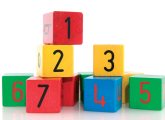In the first of two practical articles, Gill Coulson and Lynn Cousins demonstrate how you can help children to develop their language skills using everyday number games and activities…
As early years practitioners you are urged to look for opportunities to develop children’s language through play across the whole day – luckily, there’s inspiration to be found throughout the Early Years Foundation Stage, and sometimes where you’d least expect to find it. For example, although there might not seem to be any obvious link between counting and phonics, we are going to show you in this article how you can combine the two with few resources and just a little additional planning. Counting will be a part of every day’s activities in your setting, so dip into the ideas below and choose the one that best fits the session you have planned.
All of the ideas are based on Phase One of ‘Letters and Sounds’. This phase is all about making the children aware of sounds – those sounds that are all around them, those that they can make themselves – and, eventually, helping them to recognise the sounds that we use to create words. Phase One is not intended as a programme that you will follow step by step, but rather an approach you will take to develop children’s language skills across the whole curriculum. This means that you will be ‘doing phonics’ at the same time as lots of other EYFS-based activities.
There are seven aspects of phonics described in ‘Letters and Sounds’ (see panel for details), and we have divided the activities into these seven categories, so that you can keep a record of the children’s phonic experiences. They are based on the number ‘5’, but you can very easily adapt them to any number you would like to focus on…
Play a guessing game with vehicle noises. Ask a group of five children to think of five different vehicle noises – e.g. police car, racing car, ambulance, tractor, motorbike. Each child in turn makes one of the vehicle noises. Can anyone guess which one it is? Next time try five farm animals, zoo animals or pets.
Arrange some chairs to represent a bus. Five children sit on the bus. Tell them where they are going – e.g. the market, seaside, zoo. Everyone tries to name a sound they will hear there.
Ask the children to sit on the carpet. Help them to count out five cups. Now ask them to close their eyes and listen carefully. Pour water into some or all of the cups. Children should count how many they hear, and hold up that number of fingers.
Help a small group of children select five different instruments. When they play one of them (hidden behind a screen) can the other children identify which instrument it was?
Use food colouring to make some coloured water. Set out five glass bottles and help a couple of children to fill them with differing amounts of the coloured water. Tap the bottles and hear the five different tones created.
Many action songs start with the number ‘5’. Try this traditional one, and a new one…
Five little men in a flying saucer
Five little men in a flying saucer
(stretch out arms to make a big flying saucer)
Flew round the world one day
(skip in a circle)
They looked left and right,
But didn’t like the sight
(turn head from side to side, then shake)
So one man flew away.
Make the flying saucer smaller as each verse is repeated for 4, then 3, 2 and 1 man.
The children could make cardboard biscuits and arrange them on a paper plate…
Five little biscuits spread out on a plate
(point to the plate of ‘biscuits’)
Lily (name a child in your group) is going to eat one,
They taste just great.
(Lily takes one of the ‘biscuits’, then makes a sound effect: yum, yum; crunch, crunch, mmmmmm; or an action: rub tummy, rub hands together and then pretends to eat the biscuit.)
Four little biscuits spread out on the plate
Josh is going to eat one,
They taste just great.
(Josh makes a different sound effect or action)
Repeat until all five biscuits have been ‘eaten’.
Any story, rhyme or poem can be used to raise children’s awareness of this aspect of phonics.
Sing ‘1 2 3 4 5, Once I caught a fish alive’.
Encourage the children to clap the rhythm of the numbers (1*2*345*) as you sing each line of the rhyme. An extra adult can help them to keep the rhythm correct as you say the words.
Try changing the creature that was caught to another one syllable word – e.g.
frog, fly, crab, ant, bird, newt.
Five little fish
Swimming in the sea
1, 2, 3, 4, 5, I see.
As the children say the numbers, they point to one finger for each number. Change the word ‘little’ for another descriptive word and repeat the rhyme.
How about striped fish, big fish, pink fish or hungry fish?
What do the children notice about the number words four and five? They start with the same sound, /f/. Two children hide their hands behind them. Ask them to choose the number ‘4’ or the number ‘5’ – secretly! When you say “Show your number”, both children show their fingers – four or five. Clap if they are both the same.
Have you any children with a name that starts with an /f/ sound, the same as number ‘5’? Challenge the children to think of five names that begin with the sound /f/ – e.g. Freddie, Fatima, Frances, Phoebe, Phillip, Fiona, Felix, Fergus, Faye, Florence.
Play a game outside on a soft surface. Use five toys that move in special ways. Show the children the toys and encourage them to name the things they can do – which all start with the sound /f/.
Plane: fly
Flag: flutter
Fridge/freezer from the dolls’ house: freeze
Rag doll: flop
Humpty Dumpty: fall
Show the toy, name the action and let the children do this action.
Can you fffffffffff ...fly?
Can you ffffffffff ...flutter?
Can you fffffffffff ...freeze?
Can you fffffffff ...flop?
Can you fffffffff ...fall?
Use these five actions to play a version of ‘Simon says’. You say the action words (no toys this time) as often as you like, and in random order. Children do the actions. Occasionally shout “five!”. Everyone has to find a friend and high-five them.
Choose five objects from the classroom – e.g. a pen, cup, shell, book, key (keep the objects to words made of only 2–3 phonemes). Make sure the children can name them before hiding the five objects in a bag. Sound out the name of one of the objects – e.g. sh-e-ll. Whoever can guess what it is reaches in the bag and finds it – without looking in the bag!
Challenge the children to work with a friend and find:
● Five b-oo-k-s
● Five c-u-p-s
● Five c-ar-s
Can they work out what to find by blending the sounds they have heard?
Read the story The Rainbow Fish by Marcus Pfister. Prepare a cardboard fish with five detachable scales made from coloured foil. Show the children the fish and choose five of them to ask for a scale each. They should use the words from the book, “Please give me one of your shiny scales”. Encourage them to try to speak in a fishy voice. Imagine trying to talk under water!
Choose a story with five main characters – e.g. Red Riding Hood, Grandma, Wolf, Woodcutter, Mummy. Choose five children to be these characters. You tell the story and whenever you mention a child’s character he or she ‘helps’ you to say the relevant words in a suitable voice.
Choose five objects from the classroom – e.g. a pen, cup, shell, book, key (keep the objects to words made of only 2–3 phonemes). Make sure the children can name them before hiding the five objects in a bag. Sound out the name of one of the objects – e.g. sh-e-ll. Whoever can guess what it is reaches in the bag and finds it – without looking in the bag!
Challenge the children to work with a friend and find:
Five b-oo-k-s
Five c-u-p-s
Five c-ar-s
Can they work out what to find by blending the sounds they have heard?
Remember, the purpose of learning phonics is to be able to read and write, so take every opportunity to share books with your children – including counting books.
● Enjoying and sharing books motivates children to value reading. Children will enjoy listening to a counting book at story time, but you can also share one at the start of the day, leave them out for children to look at during their free play, or use them as a basis for a display.
● Wibbly Pig has 10 Balloons by Mick Inkpen is a super book. It’s about friendship and sharing as well as counting, and it has rhyming words too. The publisher Little Tiger Press Group has a variety of titles to suit many popular themes, e.g. Ten Shiny Snowflakes by Russell Julian. Search online and you’ll find many more.
● Try making your own little counting books. Staple together five sheets of paper inside a cardboard cover, and number each page with a large figure, from 1–5. Write The Noisy Farm as the title. Let the children cut out and stick on the appropriate page: 1 cow, 2 ducks, 3 sheep, 4 pigs, 5 hens. Read the book together, making the animal noises, then try another theme.
Here are seven quick counting ideas that illustrate the difference between the seven aspects of phase one…
1. Environmental sounds: listen carefully to all the sounds around you. Go outside and listen for five different sounds.
2. Instrumental sounds: be aware of the range of sounds made with instruments. Notice the sound getting louder as 1, then 2, then 3, 4, 5 children play shakers.
3. Body percussion: create sounds with their bodies and move in time to rhythm. Let five children stand at the front as you all sing an action song together – “If you’re happy and you know it stamp your feet…”
4. Rhythm and Rhyme: to appreciate rhythm and rhyme. Change the number word as you sing a familiar rhyme. Try Five in a bed or Five blind mice!
5. Alliteration: to start to understand that lots of words start with the same sound. Paint five snakes. Describe each one with a word that begin with ‘sss’ – slow, soft, slippery, scary, silly.
6. Voice sounds: to distinguish between vocal sounds. Record five individual children saying your name. When you play each one back, can the others guess who is speaking?
7 Oral blending and segmenting: to hear the individual sounds in a word and blend them back into a whole word. Say any number up to five in ‘sound talk’, e.g. th-r-ee. Children show that number of fingers.
Next up, read Gill and Lynne’s article on planning for a whole session of phonic activities based on a single theme – Wellies!
Gill Coulson and Lynn Cousins are experienced teachers of early years and Key Stage 1, and the authors of Games, Ideas and Activities for Early Years Phonics, part of Pearson Education’s Classroom Gems series – the second edition of which is now available.

We put play at the heart of assessment
Editors picks

Montessori number activities – Number names
Editors picks
